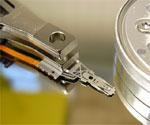Hard drives aren’t going anywhere
Though hard drives have grown smaller in size, larger in capacity, cheaper in price and faster in speed, the technology behind them has remained fundamentally the same for around fifty years. The manner of transmitting data between the hard drive and motherboard has evolved, but whether it’s Serial or SATA cables, there’s still a motherboard on one end and a system of spinning disk platters on the other.
Those disks just carry on spinning, and are likely to do so for a while, even as the data storage requirements of the world increases and people speak of new data storage technologies on the horizon. Cloud storage is often mentioned as a successor to hard drive technology, but, believe it or not, all that data going to the cloud still has to be stored somewhere. It’s not just floating around in the sky.
Then there are mobile devices, with flash memory being the storage medium of choice. The storage capacity of mobile devices is limited and every piece of data stored in the memory of a mobile device is likely to be backed up multiple times on hard disks at home or in the cloud.
What about solid state drives?
Touted as a potential usurper of the hard disk drive, solid state drives store data electronically rather than magnetically, using flash memory chips rather than spinning disk platters. With read and write times that can reach as high as 550MBps versus the 200MB of your fastest hard disk drives,solid state drives boast superior speeds that enable them to boot Windows 7 about 30 seconds faster than hard drives.
They make a lot less noise, too. Solid state drives contain no moving parts, which means that there are no parts to break in the event of physical trauma.
If they’re so fast and durable, surely it’s time they replaced the 50-year-old technology of the hard disk drive? Well, solid state drives have been around for about 30 years, yet hard disk drives remain the data storage medium of choice for most consumers.
One reason is that being faster and more durable doesn’t make them immune to drive failure. In fact, drive failure is included on the list of things to which solid state drives are more vulnerable than hard disk drives. The latter will usually give some warnings signs first.
The major factor is expense, with solid state drives costing about $0.70 to $1 per gigabyte of data versus a few cents per gigabyte for hard disk drives. In 2011, consumers purchased about 350 billion gigabytes worth of hard drive capacity, providing the industry with $33 billion worth in revenue. The same amount of gigabytes in solid state drive capacity would have come to $250 billion.
The first gigabyte hard drive in the 80s cost between $81,000 and $142,400, surely the price of solid state drives will also drop over time?
Solid state drive prices have indeed dropped over time and may drop further, but the price drops are volatile, and dependent on the availability of the lithography used to manufacture them. Either way, they’re not likely to drop at a faster rate than hard disk drives, so the price gap will remain wide.
Who knows what the future will bring, but for now, hard disk drives look likely to remain the most prevalent data storage medium for a while yet.


